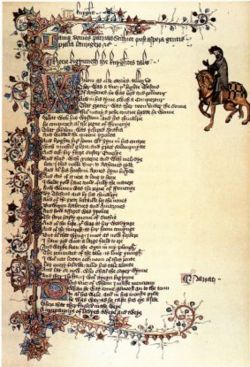Ellesmere Chaucer manuscript: Difference between revisions
imported>Lin Barneveld (+ info) |
imported>Lin Barneveld (+ Significance + Sources) |
||
| Line 4: | Line 4: | ||
The '''Ellesmere Chaucer manuscript''', also '''Ellesmere Chaucer''' or '''Ellesmere manuscript''', is an early 15th century illuminated manuscript of [[Geoffrey Chaucer]]'s ''[[The Canterbury Tales]]''. It is part of the Ellesmere manuscripts and referred to as MS EL 26 C 9. Together with the [[Hengwrt Chaucer manuscript]] it is considered to be the most important source of the original text of ''The Canterbury Tales''. The Ellesmere Chaucer is held in the [[Huntington Library]] in [[San Marino]], [[California]]. It is named after its former owner, the Earl of Ellesmere. | The '''Ellesmere Chaucer manuscript''', also '''Ellesmere Chaucer''' or '''Ellesmere manuscript''', is an early 15th century illuminated manuscript of [[Geoffrey Chaucer]]'s ''[[The Canterbury Tales]]''. It is part of the Ellesmere manuscripts and referred to as MS EL 26 C 9. Together with the [[Hengwrt Chaucer manuscript]] it is considered to be the most important source of the original text of ''The Canterbury Tales''. The Ellesmere Chaucer is held in the [[Huntington Library]] in [[San Marino]], [[California]]. It is named after its former owner, the Earl of Ellesmere. | ||
==Significance== | |||
The Ellesmere Chaucer is one of the oldest surviving manuscripts of ''The Canterbury Tales''. It was copied in the years following Chaucer's death in 1400, according to some in 1401, <ref>Evans, p. 21.</ref> to others in c. 1410. Since no holograph of Chaucer is ever found, it offers the best evidence to what he wrote.<br /> | |||
Still it was only with the publication of [[Walter W. Skeat]]'s edition of the ''Works of Geoffrey Chaucer'' in 1894, that the Ellesmere Chaucer gained its eminent textual status. After Skeat many editions were based on the Ellesmere Chaucer, including the Riverside Chaucer in 1987. Other editions were based on the Hengwrt Chaucer manuscript. In fact, no matter which of these is choosen, the other one is heavily consulted. <ref>Scala, p. 485.</ref> | |||
==Sources and references== | |||
* Ruth Evans, "Chaucer's life", in: Steve Ellis ''Chaucer An Oxford Guide'' (2005). New York United States: Oxford University Press. Inc. ISBN 0-19-925912-7 | |||
* Elizabeth Scala, "Editing Chaucer", in: Steve Ellis ''Chaucer An Oxford Guide'' (2005). New York United States: Oxford University Press. Inc. ISBN 0-19-925912-7 | |||
{{Reflist}} | |||
Revision as of 17:28, 22 April 2010
The Ellesmere Chaucer manuscript, also Ellesmere Chaucer or Ellesmere manuscript, is an early 15th century illuminated manuscript of Geoffrey Chaucer's The Canterbury Tales. It is part of the Ellesmere manuscripts and referred to as MS EL 26 C 9. Together with the Hengwrt Chaucer manuscript it is considered to be the most important source of the original text of The Canterbury Tales. The Ellesmere Chaucer is held in the Huntington Library in San Marino, California. It is named after its former owner, the Earl of Ellesmere.
Significance
The Ellesmere Chaucer is one of the oldest surviving manuscripts of The Canterbury Tales. It was copied in the years following Chaucer's death in 1400, according to some in 1401, [1] to others in c. 1410. Since no holograph of Chaucer is ever found, it offers the best evidence to what he wrote.
Still it was only with the publication of Walter W. Skeat's edition of the Works of Geoffrey Chaucer in 1894, that the Ellesmere Chaucer gained its eminent textual status. After Skeat many editions were based on the Ellesmere Chaucer, including the Riverside Chaucer in 1987. Other editions were based on the Hengwrt Chaucer manuscript. In fact, no matter which of these is choosen, the other one is heavily consulted. [2]
Sources and references
- Ruth Evans, "Chaucer's life", in: Steve Ellis Chaucer An Oxford Guide (2005). New York United States: Oxford University Press. Inc. ISBN 0-19-925912-7
- Elizabeth Scala, "Editing Chaucer", in: Steve Ellis Chaucer An Oxford Guide (2005). New York United States: Oxford University Press. Inc. ISBN 0-19-925912-7
